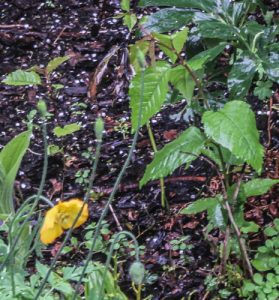Now that greenhouse tomatoes are growing well, remove the side shoots of ‘cordon’ varieties, as they appear, using your finger and thumb, this will create a single productive stem. Keep the compost constantly moist, particularly if you are using growing bags, as the compost dries out rapidly; twice a day is ideal, depending on the weather. Erratic watering causes calcium deficiency which appears as ‘blossom end rot’, later in the season, when the end of the fruit furthest away from the stem, collapses and turns black. Calcium deficiency can be a problem in apples too, where it is known as Bitter Pit, with brown spots appearing just below the surface and the fruit tasting bitter. It is more common on large fruited cultivars like ‘Bramley’s Seedling’ and ‘Newton Wonder’, usually during dry summers. The problem can be resolved by watering before trees suffer from drought stress, mulching and thinning crops to reduce the calcium requirement or spraying with calcium nitrate.
When thinning vegetables in the plot, put your fingers around the base of those you want to keep and gently ease out the weaker seedlings around them to minimise root and soil disturbance until you reach the desired spacing. It’s easier to thin when the soil is moist, so water beforehand, particularly in dry weather. ‘Carrot fly’ are attracted to the crop by the smell of the juice and can detect one molecule over 1km away so avoid problems, by thinning carrots when it’s overcast and water again after thinning. You don’t have to pull unwanted seedlings out by the roots, just pinch off the tops just above soil level with your fingernail and thumb. If you ‘station sow’ by putting two or three seeds at the correct spacing and removing the weakest ones, it not only reduces thinning but saves on seed.

I am particularly peeved by the suckers that have appeared from the rootstock of Prunus maackii ‘Amber Beauty’ (as shown in the image). Leave them to grow and they’ll eventually swamp the parent plant or in this case, choke the border. As soon as suckers appear remove the soil from around the base of each one and tear them off at the point where it is connected to the root. Cutting them off at ground level, only stimulates the dormant buds into growth and you’ll end up with several instead of one. ‘Suckers’ that appear in the lawn should treated the same way after carefully lifting the turf. Lilac’s and roses grown from hardwood cuttings avoid this problem and some nurseries now propagate them that way.
While we’re talking ‘Lilac’s’ don’t forget to remove the ‘dead head’s’ after immediately after flowering taking care not to damage the new shoots near the base, these often develop while the plant is in flower and provide next year’s blooms. One of their less appealing features is that white flowers turn brown as they die. It’s a good reason for avoiding white flowered cultivars as the contrasting colours are less noticeable in darker flowered varieties.
Happy Gardening! Matt.










